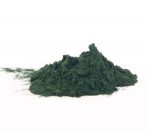
Red seaweeds make up a significant portion of the algae that are found throughout the world. They are characterised by having a vibrant red-maroon colour which sets them apart from green algae. Whether they would make a good red colour for food and beverages is another question. It is one though that regularly gets asked as food developers seek new natural colours which might replace synthetic ones for example like Allura Red (Solymosi et al., 2015; Vinha et al., 2018).
The algal phylum of the Rhodophyta is one of the oldest groups of algae known about. There are over 6,500 species in this group alone. It’s not without some hope that one of their number might offer a useful and natural red pigment for colouring foods. One algae is already a provider of colour but in another part of the spectrum.
The colour from Spirulina algae is now established as major blue-green pigment for use in all sorts of food materials including snacks because of its excellent stability. Natural and stable blue-green colours are not easy to find but the pigment combinations from this blue-green algae have proved highly beneficial.
As in Spirulina, the pigments are composed of phycobiliproteins which are pigment-protein complexes. The phycobiliprotein is part of the the light harvesting system that generates carbohydrates and other energy molecules of algae, especially when they are in deeper water and light cannot penetrate the sea layers. There are three pigments – phycocyanin, allophycocyanin and phycoerythrin.
Phycoerythrin: Key Component In Red Seaweeds
R-phycoerythrin (RPE) is a red fluorescent pigment which is found in all red seaweeds. It is a protein with a molecular weight of 240,000 Daltons, and is made of three subunits of molecular weight 20, 000, 21,000 and 30,000. It is a key accessory photosynthetic pigment in red algae where it has had several commercial applications including use as a natural food colourant (Rossano et al., 2003)
The red seaweed Gracilaria crassa might be a good source of phycobiliproteins. Studies on their extraction show that they are importantly aqueous soluble which makes extraction straightforward and that the addition of salt (5 per cent w/w) extends their stability further. Further purification is possible using ion-exchange chromatography as with DEAE diethylaminoethyl-) cellulose (Sudhakar et al., 2015) . These authors also looked at colouring puddings.
Another potential seaweed source could be Arthrospira platensis. Red pigments from this seaweed include a range of phycobiliproteins and C-phycocyanin (Pan-utai & Lamtham, 2019). The seaweed was initially oven dried before any pigments were extracted. The pigments were extracted from macerated seaweed which was treated by homogenisation and ultrasound in a 0.01M phosphate buffer and then all the pigments were bound to activated charcoal. Such techniques complement those used by others investigating the extraction of compounds like allophycocyanin from the same algae (Tavanandi et al., 2019). These authors have used a combination of surfactant and enzyme-assisted extraction methods to release the red pigments. Any biomass left over allowed for carotenoid extraction and recovery and they obtained 80 percent of the material possible. They used low-humidity drying to create the biomass for the carotenoid extraction and then ethanol extraction (80 per cent EtOH) to release the carotenes and other pigments from the biomass.
At this moment in time there are few patents exploiting the use of phycoerythrin.
References
Pan-utai, W., & Lamthan, S. (2019) Extraction, purification and antioxidant activity of phycobiliprotein from Arthrospira platensis. Process Biochem. 82 (July) pp. 189-198 (Article)
Rossano R, Ungaro N, D’Ambrosio A, Liuzzi GM and Riccio P. (2003) Extracting and purifying R-phycoerythrin from Mediterranean red algae Corallina elongata Ellis & Solander. Journal of Biotechnology 101(3) pp. 289–293.
Solymosi, K., Latruffe, N., Morant-Manceau, A., Schoefs, B. (2015) Chapt. 1 – Food colour additives of natural origin. In: Color Additives for Foods and Beverages. Woodhead Publ. series in Food Science, technology and Nutrition. pp. 3-34 (Article)
Sudhakar, M.P., Jagatheesan, A., Perumal, K., Arunkumar, K. (2015) methods of phycobiliprotein extraction from Gracilaria crassa and its applications in food colourants. Algal Res. 8 March pp. 115-120 (Article)
Tavanandi, H.A., Vanjari, P., Raghavarao, K.S.M.S. (2019) Synergistic method for extraction of high purity Allophycocyanin from dry biomass of Arthrospira platensis and utlization of spent biomass for recovery of carotenoids. Sep. Purif. Technol. 225 pp. 97-111 (Article)
Vinha, A.F., Rodrigues, F., Nunes, M.A., Oliveira, M.B. P.P. (2018) Chapt. 11 – Natural pigments and colourants in foods and beverages. In: Polyphenol: Properties, Recovery and Colourants in foods and beverages. Woodhead Publ. pp. 363-391 (Article)


Leave a Reply